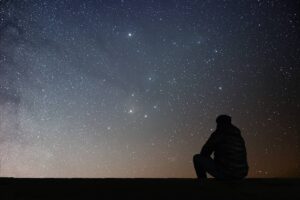
M13 – Globular Cluster in Hercules
Globular clusters are gravitationally bound concentrations of stars, which form a nearly spherical system around our galaxy. They orbit the galactic center along highly elliptical paths, and on average one revolution takes 300 million years.
These wondrous swarms of ancient suns are impressive sights in almost any telescope. The greatest of the globular star clusters, and one of the nearest to the Earth, is the magnificent Omega Centauri, some 17,000 light years distant and visible to the naked eye. Unfortunately, it can only be observed from the Southern Hemisphere.
However, there is also a beautiful star cluster for us, Northern Hemisphere types. M13, the Great Cluster in Hercules, teeters on the edge of naked eye visibility and appears in binoculars as a small, circular, hazy glow. It contains over 300,000 stars, and its luminosity is 300 thousand times the Sun.
The cluster is located in the “Keystone” of Hercules, about a third of the way along a line drawn from Eta to Zeta Herculis, and any optical aid will reveal it. Small refractors or large binoculars show a large, bright smudge, but resolution of individual stars is difficult. A 4.5-inch telescope starts to show stars at the cluster’s edge as individual points, and with a 6-inch scope their images are strong and steady.
With 8- and 10-inch instruments the size of the cluster swells a bit, and the clarity of individual stars closer to the center increases. Nevertheless, resolving the bright core into stars is nearly impossible. Careful observers with 6-inch or larger instruments might also notice dark patches against the disk of the cluster. The cause is probably intervening interstellar matter.
After studying M13 through your telescope, imagine now the sky as from deep within the cluster. We would see uncountable numbers of blazing stars, many as bright or brighter than our naked eye planets. Inhabitants on a planet inside M13 would probably know nothing of the Galaxy and other galaxies, as their view would be completely blocked by the brilliance of their own skies. To them, the Great Cluster in Hercules would be “the Universe”.
Credits: The image used at the top of this article was taken by Keesscherer

Emil, an avid astronomy writer, formerly owned and ran nightskyinfo.com, making the universe more comprehensible for his readers. He has recently handed over its reins to Tom Urbain from starlust.org, ensuring that his legacy of simplifying the stars continues to enlighten and inspire.
Discover More Deep Sky Objects to Observe🔭
This page is part of our collection of deep-sky objects articles. If you enjoyed the read, then you’ll love the following articles.




